
Magas ladoo or Magaj is a traditional Gujarati sweet prepared from gram flour (besan), ghee, and sugar. This recipe has been passed on for generations in our family. In our house, or in most Gujarati households, magas ladoo is specially prepared on Bol Choth.
Bol Choth is a festival celebrated in Gujarat on the previous day of Nag Panchami. On this day, any milk-based or dairy products are avoided. This is observed for the welfare of cattle, especially cows.
What is Magas ladoo or Magaj?
One of the most loved sweets of Gujaratis (for us it’s after Golpapdi/Sukhdi) is magas ladoo or magaj. The traditional Gujarati magaj is prepared from basic ingredients like besan, ghee, and sugar. Usually, cardamom and nutmeg powders are added for the flavourings.
The process of preparing magas ladoo is very simple. First, besan is mixed with milk and warm ghee, and it is kept for half an hour. The mixture is passed through a sieve and roasted with ghee till it becomes light brown in color and fragrant. Once this mixture becomes cool, sugar is added. You can add cardamom powder, nutmeg powder, and nuts, based on your preference. Then, you can either set the mixture on a plate and make square pieces or shape it in ladoos.

What is Dhrabo?
Dhrabo is a process that is the most important step in sweets like magas and mohanthal. Besan is combined with milk and warm ghee. Rub it between your palms till it resembles a breadcrumb-like texture. The mixture is kept for half an hour and passed through a sieve. This process is done to get the desired grainy texture, which is a must for sweets like mohanthal and magaj.
Ingredients
Besan – 2 varieties of besan can be used for making magas ladoo or magaj – coarse besan and fine besan
Ghee – Use homemade ghee if possible. For the dhrabo process, use melted, warm ghee
Milk – Use room temperature milk for the dhrabo process
Sugar – Use powdered sugar. You can blend granulated sugar in a mixer/blender jar to make a fine powder. Remember to add sugar only after the besan mixture is completely cooled.
Elaichi & Nutmeg Powder – We have added elaichi and nutmeg powder for the flavour. You can add any one or skip both based on your preference.
Nuts – We have added chopped almonds and pista to the ladoo mixture and also topped the ladoos with sliced nuts. You can skip the nuts if you do not like them.
How to make Magaj (Magas) | Step-by-Step Recipe
Take besan in a wide bowl. Make a well/hole in the center and add milk and melted warm ghee.
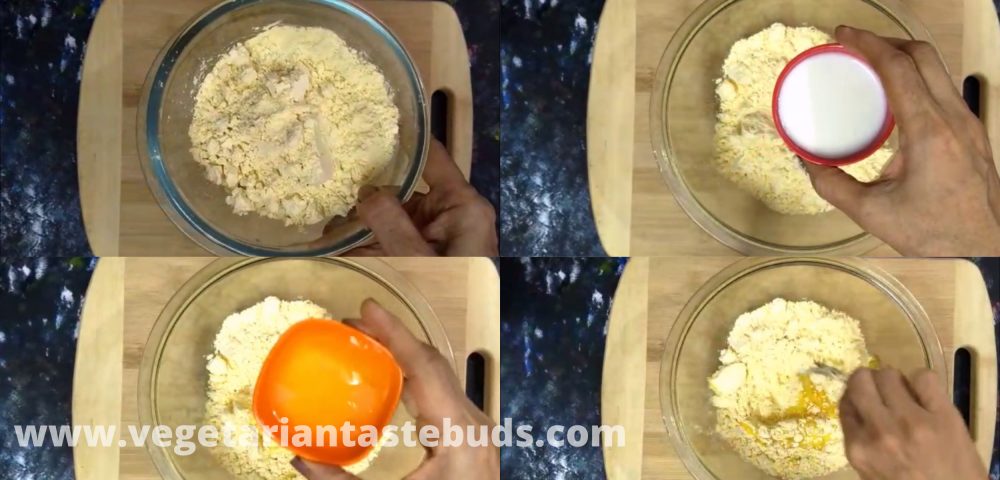
Mix well, first with a spoon, and then rub with your fingers or between your palms to get a crumbly texture. Cover and keep this aside for half an hour. This process is called Dhrabo Devo in Gujarati. We are doing this process to get the grainy texture of magas ladoo.
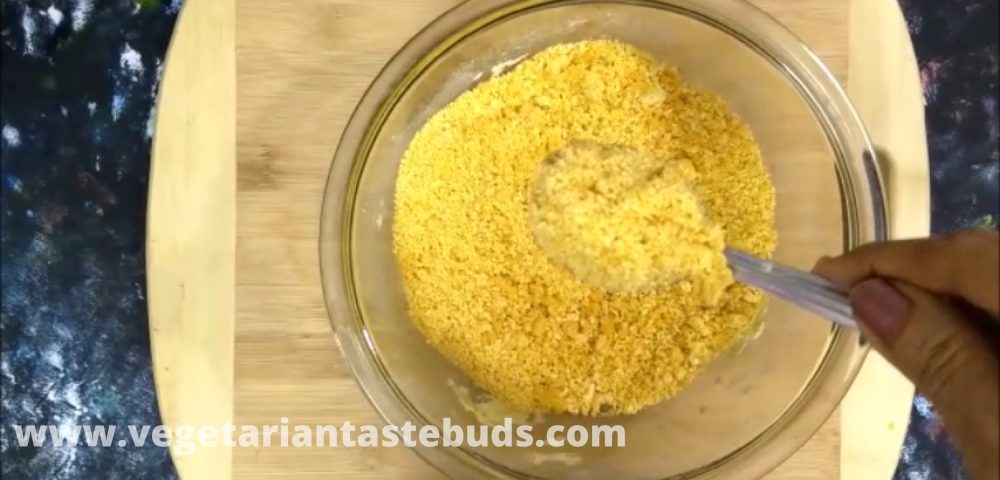
After half an hour, sift this mixture through a medium-hole sieve. You can crumble the mixture between your palms to break the lumps, so passing the mixture through the sieve becomes easy.
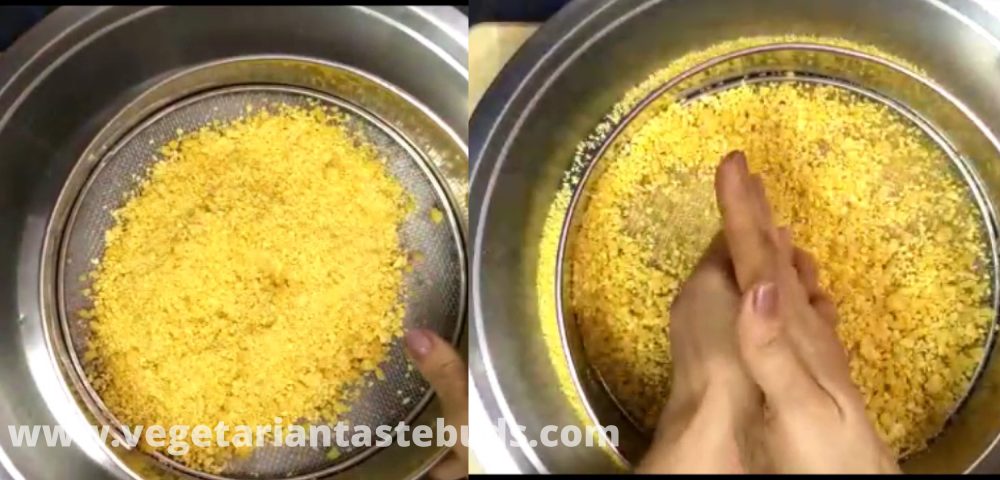
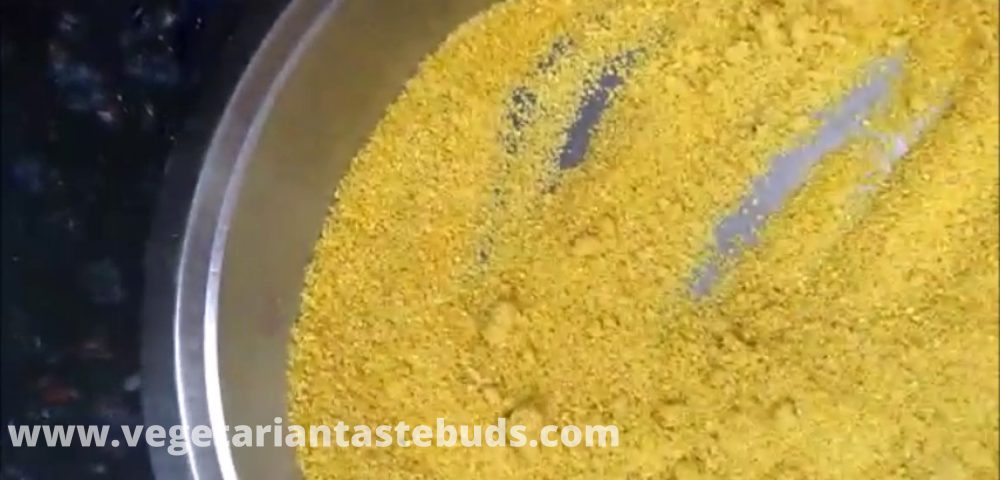
Now, heat ghee in a non-stick pan and add sifted besan mixture to it.
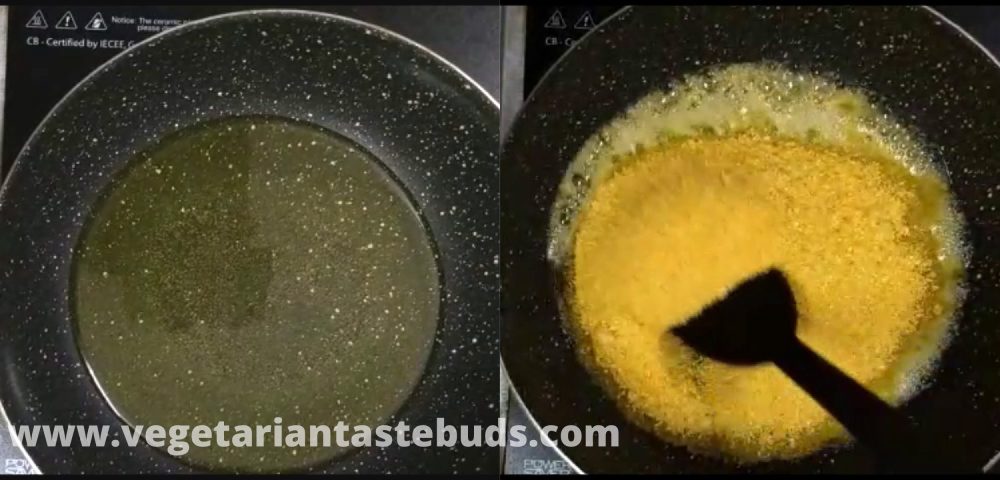
Cook this mixture on a low-medium flame till it becomes light golden in color and fragrant. Keep stirring continuously. It may take 10-12 minutes. Ensure you roast the mixture well, otherwise, it will stick in the mouth while eating. Roasting time also depends on the quantity of ingredients. If you are using 2 cups besan, then it might take more time. Besan mixture will become light, fragrant and brown in color.
Remove from flame and let the mixture cool completely.
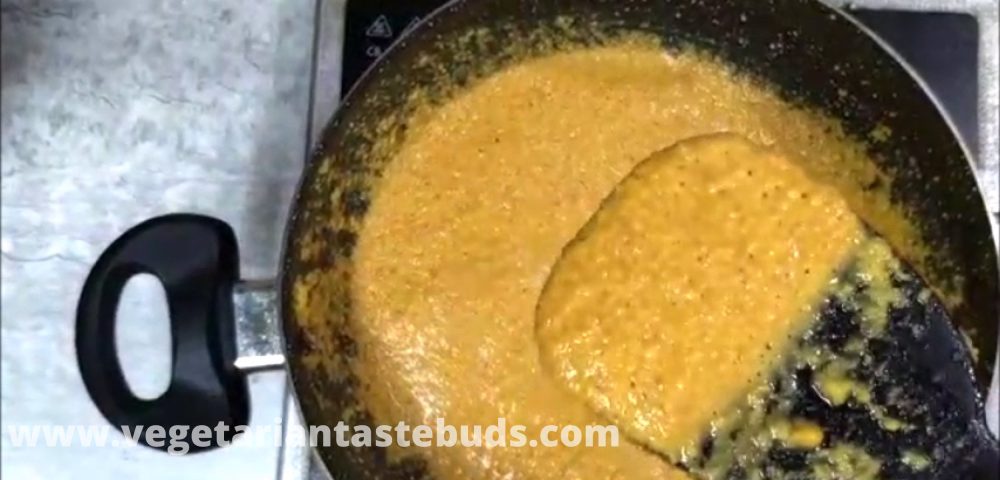
Once the mixture becomes cool, add sugar, cardamom powder, nutmeg powder, and chopped nuts. Mix well.
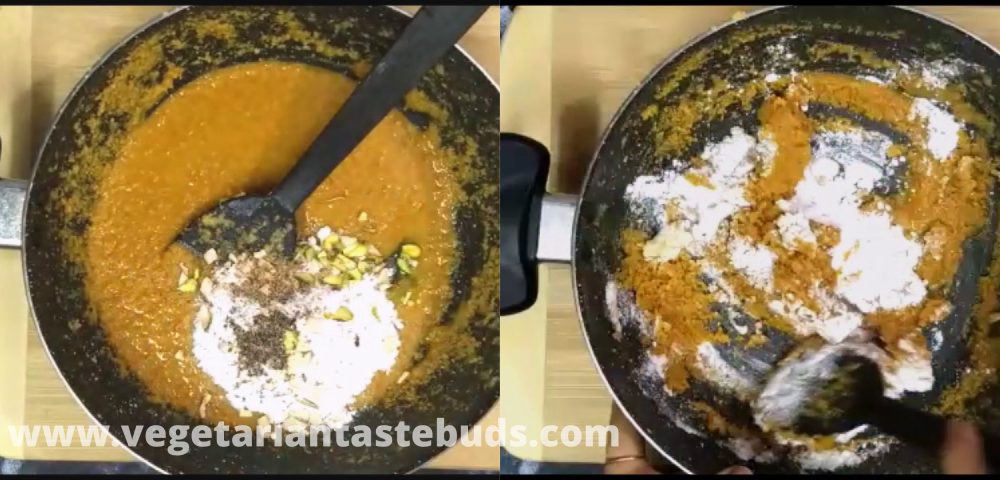
You can either make small balls from this mixture and garnish them with chopped nuts. You can also pour this mixture into a greased plate, sprinkle chopped nuts, and let it sit for 1-2 hours. Then cut it into square pieces.
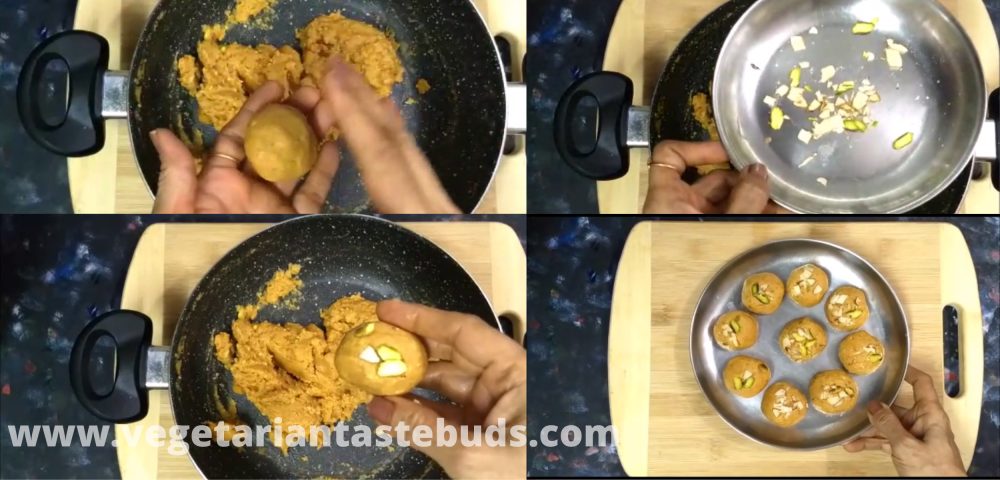
Pro Tips
- We have used regular besan flour (fine texture) for the recipe. But if you like a more coarse texture, you can use laadu/laddu besan (coarse gram flour).
- Roast the besan on low-medium flame and keep stirring continuously while roasting. If you roast the besan on high flame, the mixture will have the required colour (light brown), but it will not be cooked properly, and you will get a raw taste from magaj ladoos.
- We have prepared ladoos from the mixture, but you can set it on a plate and make square pieces.
- Make sure that the besan mixture is completely cool when adding sugar. If it is slightly warm, the mixture will become loose and sticky and will not set.
Frequently Asked Questions (FAQs)
Is there any difference between Magas and Besan Barfi?
When it comes to the ingredients, they are the same for both magas and besan barfi. The difference lies in the process of preparing them. In Gujarati magas recipe, dhrabo is the main part done to get the desired grainy texture. North Indian besan barfi is smooth in texture, and sugar syrup is added for the sweetness. Whereas in Magas, we add powdered sugar.
Are Magas and Mohanthal the same?
No. Even though both magas and mohanthal are from Gujarati cuisine, they are different. The main difference is that in magas, powdered sugar is added, whereas sugar syrup is added to mohanthal. Do try our Mohanthal recipe prepared without using mawa.
Why magas ladoo mixture is loose and sticky?
When you add sugar to the besan mixture, it should be completely cool. Even if it is slightly warm, the mixture will become loose and sticky and will not set. In this case, you can add crushed or powdered nuts to the mixture, and then it will be easy to make ladoos or pieces. Just blend a handful of nuts in the mixer jar until it becomes powder.
More Sweets & Desserts Recipes
Recipe Card
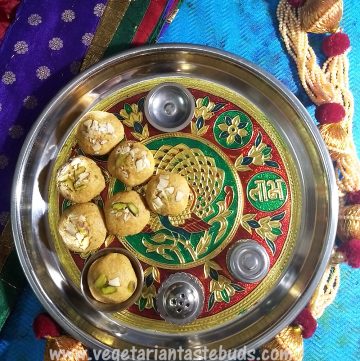
Magas Ladoo | Traditional Gujarati Magaj Recipe
Loved this recipe? Leave a comment below and give us a 5★ rating
Ingredients (1 cup = 240 ml)
To be mixed (it is called Dhrabo in Gujarati)
- 1 cup besan/gram flour/chickpea flour
- ½ tablespoon milk room temperature
- ½ tablespoon melted warm ghee
Other Ingredients
- 1/3 cup ghee
- 1/3 cup powdered sugar
- ½ teaspoon cardamom/elaichi powder
- ¼ teaspoon nutmeg/jaiphal powder
- 4-5 almonds chopped
- 4-5 pistachios/pista chopped
For the garnish
- pista sliced
- almonds sliced
Instructions
- Take besan in a wide bowl. Make a well/hole in the center and add milk and melted warm ghee.
- Mix well, first with a spoon, and then rub with your fingers or between your palms to get a crumbly texture.
- Cover and keep this aside for half an hour. This process is called Dhrabo Devo in Gujarati. We are doing this process to get the grainy texture of magas ladoo.
- After half an hour, sift this mixture through a medium hole sieve. You can crumble the mixture between your palms to break the lumps, so passing the mixture through the sieve becomes easy.
- Now, heat ghee in a non-stick pan and add sifted besan mixture to it.
- Cook this mixture on a low-medium flame till it becomes light golden in color and fragrant. Keep stirring continuously. It may take 10-12 minutes. Make sure you roast the mixture well, otherwise it will stick in the mouth while eating. Roasting time also depends on the quantity of ingredients. If you are using 2 cups besan then it might take more time. Besan mixture will become light, fragrant and brown in color.
- Remove from flame and let the mixture cool completely.
- Once the mixture becomes cool, add sugar, cardamom powder, nutmeg powder, and chopped nuts. Mix well.
- You can either make small balls from this mixture and garnish them with chopped nuts.
- You can also pour this mixture into a greased plate, sprinkle chopped nuts, and let it sit for 1-2 hours. Then cut it into square pieces.
- Magas can stay fresh for up to 2 weeks.
Video
Notes
- We have used regular besan flour (fine texture) for the recipe. But if you like a more coarse texture, you can use laadu/laddu besan (coarse gram flour).
- Roast the besan on low-medium flame and keep stirring continuously while roasting. If you roast the besan on high flame, the mixture will have the required colour (light brown), but it will not be cooked properly, and you will get a raw taste from magaj ladoos.
- We have prepared ladoos from the mixture, but you can set it on a plate and make square pieces.
- Make sure that the besan mixture is completely cool when adding sugar. If it is slightly warm, the mixture will become loose and sticky and will not set.
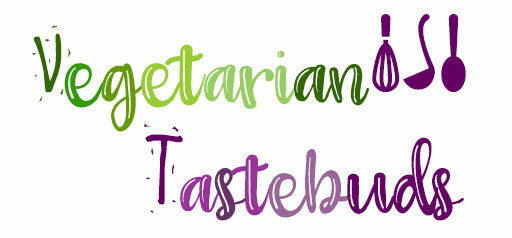
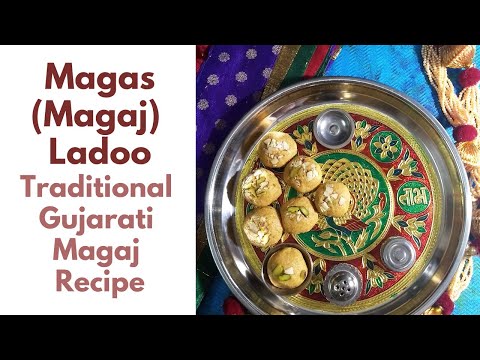
Leave a Reply